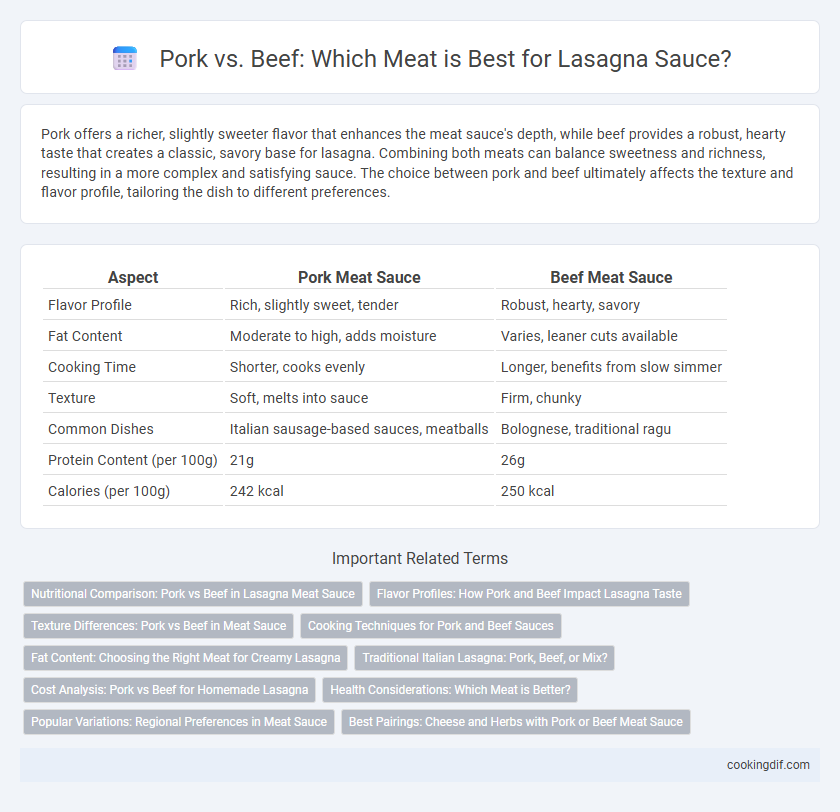Pork offers a richer, slightly sweeter flavor that enhances the meat sauce's depth, while beef provides a robust, hearty taste that creates a classic, savory base for lasagna. Combining both meats can balance sweetness and richness, resulting in a more complex and satisfying sauce. The choice between pork and beef ultimately affects the texture and flavor profile, tailoring the dish to different preferences.
Table of Comparison
| Aspect | Pork Meat Sauce | Beef Meat Sauce |
|---|---|---|
| Flavor Profile | Rich, slightly sweet, tender | Robust, hearty, savory |
| Fat Content | Moderate to high, adds moisture | Varies, leaner cuts available |
| Cooking Time | Shorter, cooks evenly | Longer, benefits from slow simmer |
| Texture | Soft, melts into sauce | Firm, chunky |
| Common Dishes | Italian sausage-based sauces, meatballs | Bolognese, traditional ragu |
| Protein Content (per 100g) | 21g | 26g |
| Calories (per 100g) | 242 kcal | 250 kcal |
Nutritional Comparison: Pork vs Beef in Lasagna Meat Sauce
Pork and beef offer distinct nutritional profiles for lasagna meat sauce; pork typically contains more fat and calories, while beef provides higher iron and zinc levels essential for muscle function and immunity. Lean cuts of pork such as tenderloin have comparable protein content to lean ground beef but with slightly less saturated fat. Choosing between pork and beef depends on dietary goals, balancing calorie intake with nutrient density for a wholesome lasagna meat sauce.
Flavor Profiles: How Pork and Beef Impact Lasagna Taste
Pork imparts a sweeter, richer flavor with subtle fatty undertones that enhance the depth of the meat sauce in lasagna, creating a tender, moist texture. Beef provides a robust, hearty taste with a more pronounced umami character, resulting in a stronger savory backbone that balances well with tomato and herbs. Combining pork and beef in meat sauce yields a complex flavor profile, blending pork's sweetness and beef's intensity for a perfectly layered lasagna experience.
Texture Differences: Pork vs Beef in Meat Sauce
Pork in meat sauce offers a tender, juicy texture that melts smoothly into the lasagna layers, creating a rich mouthfeel. Beef provides a denser, firmer texture, adding a robust chew that contrasts with the creamy cheese and pasta. Combining both meats balances tenderness and hearty bite, enhancing the overall texture complexity of the sauce.
Cooking Techniques for Pork and Beef Sauces
Pork meat sauce for lasagna often benefits from slow simmering to render its natural fat and develop a rich, tender texture, while beef sauce typically requires browning to deepen its robust flavor and create a hearty base. Pork's higher fat content allows for a creamier sauce, often enhanced with garlic and herbs during braising, whereas beef sauce relies on searing and deglazing with wine or stock to build complexity. Both meats perform best when cooked low and slow, but pork demands gentler handling to maintain moisture, and beef calls for high-heat techniques to maximize Maillard reactions.
Fat Content: Choosing the Right Meat for Creamy Lasagna
Beef typically contains higher fat content than pork, which contributes to a richer and creamier meat sauce for lasagna. Pork, especially lean cuts, offers a lighter texture with less grease, ideal for those seeking a balanced flavor and reduced fat. Combining ground pork and beef achieves an optimal blend of fat and flavor, enhancing the sauce's creamy consistency without overwhelming the dish.
Traditional Italian Lasagna: Pork, Beef, or Mix?
Traditional Italian lasagna often features a meat sauce made from a combination of pork and beef, balancing the rich, fatty flavor of pork with the leaner, robust taste of beef. In regions like Emilia-Romagna, pork is favored for its moist texture and depth, while beef contributes a hearty consistency, making the mix ideal for authentic ragu alla Bolognese. Using solely pork or beef changes the sauce's texture and flavor profile, but the classic blend maintains the perfect harmony in traditional Italian lasagna.
Cost Analysis: Pork vs Beef for Homemade Lasagna
Pork typically costs 10-20% less per pound than beef, making it a budget-friendly option for homemade lasagna without compromising on protein quality. Beef, especially ground chuck or sirloin, offers richer flavor profiles but comes with a higher price point, averaging between $5 and $8 per pound compared to pork's $4 to $6. For cost-conscious cooks, blending pork and beef can optimize both flavor and expense, balancing taste richness with affordable sourcing.
Health Considerations: Which Meat is Better?
Beef contains higher levels of saturated fat and cholesterol compared to pork, raising concerns about heart health when consumed excessively in lasagna meat sauce. Pork, especially lean cuts, offers a favorable fat profile with more unsaturated fats and essential nutrients like B vitamins, supporting better cardiovascular health. Choosing lean pork over fatty beef can reduce calorie intake and promote a healthier meat sauce option for lasagna recipes.
Popular Variations: Regional Preferences in Meat Sauce
Pork-based meat sauces dominate traditional Italian lasagna recipes, particularly in regions like Emilia-Romagna where rich, fatty pork enhances the sauce's depth and texture. Beef is more commonly preferred in American lasagna variations, offering a leaner flavor profile that appeals to diverse palates and complements robust tomato sauces. Regional preferences in meat sauce choices significantly influence lasagna's taste and authenticity, reflecting local culinary traditions and ingredient availability.
Best Pairings: Cheese and Herbs with Pork or Beef Meat Sauce
Pork meat sauce in lasagna pairs exceptionally well with creamy ricotta and tangy parmesan cheeses, enhancing its slightly sweet and rich flavor profile, while fresh sage and thyme herbs complement the savory notes. Beef meat sauce offers a robust and hearty base that balances perfectly with sharp pecorino and melted mozzarella, accented by aromatic rosemary and oregano to deepen the umami taste. Selecting pork or beef influences the ideal cheese and herb combinations, creating distinct yet equally delicious lasagna experiences.
Pork vs Beef for meat sauce Infographic

 cookingdif.com
cookingdif.com